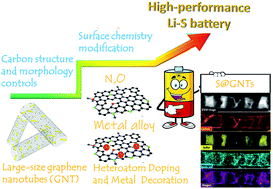Large-diameter and heteroatom-doped graphene nanotubes decorated with transition metals as carbon hosts for lithium–sulfur batteries†
Abstract
This work addresses performance issues of lithium–sulfur (Li–S) batteries via retaining the polysulfide intermediates within a novel cathode nanocarbon host. Herein, we report a series of nitrogen and oxygen co-doped and transition metal-decorated large size (200–500 nm in diameter) graphene nanotubes (M-GNTs) (M = Co, Ni, and/or Fe) as effective carbon hosts for sulfur cathodes (S@M-GNTs) in Li–S batteries. The exceptionally large diameters of the graphene tubes allow facile diffusion of sulfur inside the tubes with sufficient loadings, yet leaving room for volume expansion during the lithiation process. The GNTs with the largest diameter and abundant N and O doping along with FeCoNi alloy decoration (FeCoNi-GNTs) exhibit the best sulfur cathode performance. In addition to the unique nanocarbon structures, the heteroatom dopants and transition metal nanoparticles likely also play promotional roles in retaining long-chain polysulfide discharge intermediates within the carbon host, therefore improving rate capability and cycle stability. In particular, a S@FeCoNi-GNT cathode with a high sulfur loading (∼4.5 mgS cm−2) exhibits discharge capacities up to 1234.7 mA h g−1 at C/20 and 909.0 mA h g−1 at C/5. A discharge capacity of 554.4 mA h g−1 at 1C after 500 cycles was retained, further demonstrating its encouraging potential in Li–S batteries.



 Please wait while we load your content...
Please wait while we load your content...